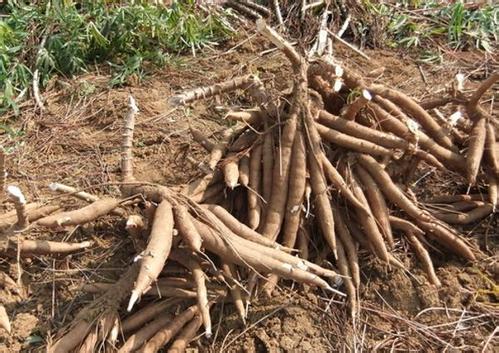What is cassava? The efficacy and function of cassava and is cassava a yam?
Organic cultivation of cassava
Cassava, erect shrubs, 1.5-3 m tall; roots Terete. Leaves papery, suborbicular in outline, palmately parted almost to base, lobes 3-7, oblanceolate to narrowly elliptic, apex acuminate; petiole 8-22 cm long, slightly peltate, with inconspicuous fine ribs; stipules triangular-lanceolate, entire or with 1-2 setose lobes. Inflorescences terminal or axillary, bracts striate-lanceolate; calyx purplish red and glaucous; male flowers: Calyx ca. 7 mm, lobes long-ovate, subequal, inner surface hairy; stamens 6-7 mm long, anthers apically covered with white short hairs; female flowers: Calyx ca. 10 mm, lobes oblong-lanceolate, stigma incurved, flabellate. Capsule ellipsoid, surface rough, with 6 narrow and undulate longitudinal wings; seeds ca. 1 cm, ±trigonous, seed coat hard crustaceous, striate, smooth. The florescence is from September to November.
Cassava has the ability to survive under the condition of low input and water shortage and resistance to diseases and insect pests, good seed, good management and few diseases and insect pests, so it is suitable to be used as a crop for organic ecological farm. The agricultural improvement farm in Kaohsiung District of the Council of Agriculture has been tested in organic ecological farms for 90 and 91 years, and the yellow meat species and white meat species with good root quality have been selected and recommended for organic farmers.

The agricultural improvement farm in Kaohsiung District pointed out that close planting of cassava would reduce the harvest index and the yield of qualified products of root tuber. the suitable row spacing was 200x100cm and the amount of compost was 10000 ~ 20000 kg / ha. At maturity, the plant height of yellow meat species is 365 cm and that of white meat species is 432 cm. Can be planted all year round, when planting, cut mature branches 20 cm when cuttings, bud points upward, and the whole garden irrigated to promote germination. Moderate irrigation during childbearing can promote fertility, but do not get too wet. It can be harvested about 8 months after planting, and the water was cut off one month before harvest to improve the quality of root tubers. In terms of yield, the yield of yellow meat species can reach 45 metric tons per hectare and that of white meat species can reach 35 metric tons.
The agricultural improvement farm in Kaohsiung District said that the cassava varieties cultivated in the past were mainly used for processing, mainly extracted starch, poor edible quality and high cyanide content. The two varieties recommended by the agricultural improvement farm in Kaohsiung District are suitable for cooking and eating. the roots are peeled off and cooked in pieces, which is sweet and salty, and can also be made. They have excellent edible quality and low cyanide content, so they are non-toxic varieties. Among them, the yellow meat becomes golden after cooking, the texture is fragrant Q, and the taste is excellent; the white meat is fine in texture and not greasy. Due to the lack of long-term storage of fresh potatoes, the quality of fresh potatoes is easy to deteriorate 2 ~ 3 days after harvest, which can be peeled and frozen for up to 6 months.
The efficacy and function of cassava:
Cassava has a very high nutritional value, which can not only be eaten by human beings, but also can be raised by livestock. And most people make cassava starch into glucose, maltose, alcohol, beer, bread and other foods, can also be made into chemical products. The leaves of cassava are also very valuable, they can be used as feed, and the roots of cassava can be processed into food and other things, although cassava contains high nutritional value, but cassava itself contains toxic toxins to the human body, so we should do a good job of dealing with toxins before eating, so that we can rest assured to eat.
Is cassava a yam? No, there's a big difference.
- Prev

Organic tea planting: organic tea garden management, organic tea planting technology
The significance of organic cultivation in organic tea garden is to avoid the use of chemical synthetic pesticides and chemical fertilizers to produce tea. Its purpose is to maintain the health of tillers and consumers and to protect the ecological environment of the earth. The way of organic cultivation in tea garden lies in the use of
- Next

Control of common corn diseases and insect pests, how to do corn pest control measures?
The control strategies of diseases and insect pests in corn organic cultivation are leaf spot, coal sheath, rust, mosaic disease, corn borer and aphids, and the occurrence of diseases and insect pests is closely related to climatic conditions. therefore, climatic factors and field diseases should be considered.
Related
- A one-day flower show brings 130 million yuan in orders! Nanhai, this Phalaenopsis exhibition is amazing
- What do the flower language and meaning of Lutheran tree mean? Precautions for planting Lutheran tree
- Encounter Chaoshan Kongfu tea, not without this cup of Phoenix single clump
- The durian market in Vietnam and Thailand is flooded. The price of imported durian has plummeted by 30-40% in a month.
- Shanghai solved the problem of local vegetable supply by planting 80,000 mu of green leafy vegetables.
- Wageningen University has become the best agricultural university in the world for the seventh time in a row.
- The strongest export season of South African grapes is full of challenges, with exports to Russia falling sharply by 21%.
- Sri Lanka is on the verge of bankruptcy, "Tea for debt" Organic Agriculture Revolution aggravates the Food crisis?
- Turning waste into earthworm manure and worm manure into organic fertilizer-A new choice for auxiliary farming
- Organic rice growers shoulder the responsibility of nurturing agricultural talents! Yinchuan Sustainable Farm with Organic Life Camp

